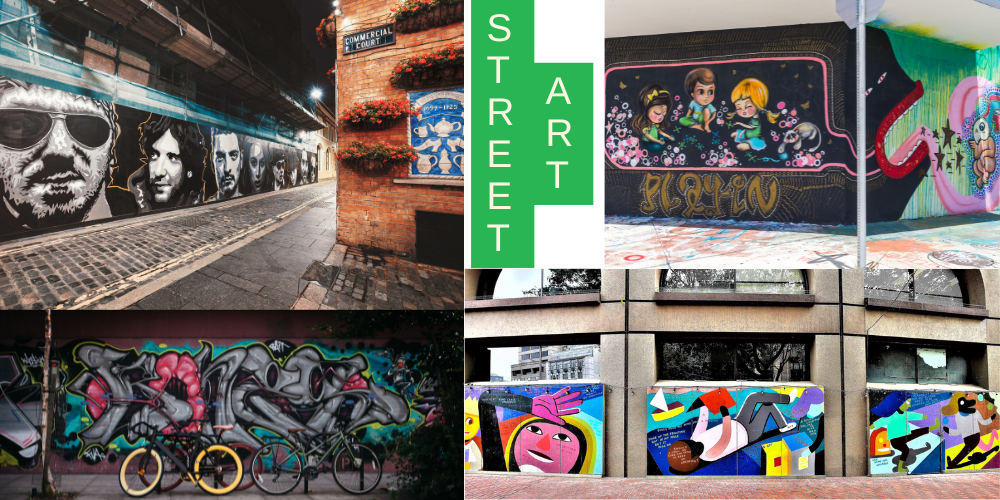Street art. It’s the beating heart of the city, a furious shout back to sterile concrete, and a space for the unmediated voice of the people. But it’s also so much more than spray paint on a brick wall. From Banksy’s elaborate stencils to towering murals by ROA, street art has grown into an international force, disrupting how we view art, public space, and the very nature of our urban environments.
The Streets as a Canvas: A Brief History
While the modern street art movement gained momentum in the 1980s with the rise of graffiti culture in New York City, its roots run far deeper. Early cave paintings, ancient Roman graffiti, and even the protest slogans of the French Revolution can be seen as precursors to today’s street art.
The 20th century saw a surge of artistic expression spilling onto the streets. The Situationist International (SI) in the 1950s and 60s used urban spaces for subversive political messaging. At the same time, the Chicano mural movement in the US embraced public art as a tool for social commentary and cultural celebration.
Graffiti, with its stylized lettering and tags, emerged as a powerful form of self-expression in marginalized communities. While often seen as vandalism, it paved the way for the diverse and sophisticated street art we see today.
More Than Just Spray Paint: Exploring the Diverse Forms of Street Art
Today, street art encompasses a vast array of styles and techniques:
- Murals: Large-scale paintings that transform entire walls into breathtaking works of art.
- Stencils: Intricate designs cut into stencils and spray-painted onto surfaces, allowing for quick and impactful execution.
- Wheatpasting: Posters or images printed on paper and glued to walls using a wheatpaste mixture.
- Stickers: Small, easily produced stickers featuring designs, logos, or messages, often used for rapid dissemination.
- Street Installations: Three-dimensional objects or sculptures placed in public spaces, interacting with the environment and challenging viewers’ perspectives.
- Yarn Bombing: Covering objects in public spaces with colourful knitted or crocheted yarn, adding a playful and unexpected touch.
The Masters of the Streets: Iconic Street Artists
The world of street art is filled with talented individuals who have captured the imagination of audiences worldwide. Some of the most iconic figures include:
- Banksy: The enigmatic British artist known for his satirical stencils and politically charged messages, Banksy’s identity remains a mystery, adding to his allure and the impact of his work.
- Shepard Fairey: The American artist behind the iconic “Obey Giant” campaign and the Obama “Hope” poster, Fairey’s work blends street art aesthetics with political activism.
- Invader: The French artist who “invades” cities with his signature mosaic tile Space Invaders, bringing a playful touch of 8-bit nostalgia to urban landscapes.
- JR: The French photographer and street artist known for his large-scale black and white photographic portraits pasted in public spaces, often highlighting social issues and marginalized communities.
- ROA: The Belgian artist is renowned for his striking murals of animals, often depicting them in a state of decay or interacting with their urban environment.
The Impact of Street Art: Beyond Vandalism
Street art has evolved from its rebellious roots to become a powerful force for social change, community building, and urban renewal. It:
- Challenges Perspectives: Street art disrupts the mundane, forcing us to look at our surroundings with fresh eyes and question our assumptions about art and public space.
- Sparks Dialogue: By addressing social and political issues, street art encourages dialogue and raises awareness about important causes.
- Beautifies Communities: Murals and other forms of street art can transform neglected areas, adding colour, vibrancy, and a sense of pride to neighbourhoods.
- Fosters Creativity: Street art inspires creativity and self-expression, providing an outlet for artists from all backgrounds to share their vision with the world.
- Boosts Economies: Street art can attract tourism, revitalize neighbourhoods, and increase property values, contributing to economic growth.
The Legal Gray Area: Navigating the Boundaries of Street Art
Although street art is becoming more accepted with every passing year, it is still a legal grey area. Some cities embrace it and even commission murals; others have regarded it as vandalism and brought criminal charges against artists. Navigating the thin line between art and illegality can be quite a task, and artists must often learn to walk a fine line in order to comply with these nuances.
Many street artists work under pseudonyms or anonymously to avoid criminal action. Others get permission from the property owners or take part in organized street art festivals and events. The evolving legal landscape around street art reflects the ongoing struggle between urban governance and artistic expression.
Street Art in the Digital Age: New Frontiers of Creativity
The internet has changed the game for street artists. Platforms such as Instagram have created virtual gallery spaces, giving artists opportunities to showcase their art to an audience beyond their immediate environment and the audiences of other creatives. Street art has begun to embrace digital tools and techniques that push this boundary even further so that the creative elements introduced with projection mapping, augmented reality, and other technologies can take full effect in their creations.
Conclusion: The Enduring Power of Street Art
Street art is not only a skilful display of tales; it is also a mirror to society, a voice for the marginalized, and a trigger for transformation. It invites us to infringe, to act, to reimagine urban spaces. With that said, street art is a constantly shifting genre that is breaking down barriers and will continue to be an essential part of our culture for the foreseeable future.
Disclaimer
This blog post is intended to explore the diverse world of street art and its impact on our culture. It does not condone illegal activity or vandalism. Always respect private property and local laws when engaging with street art.


